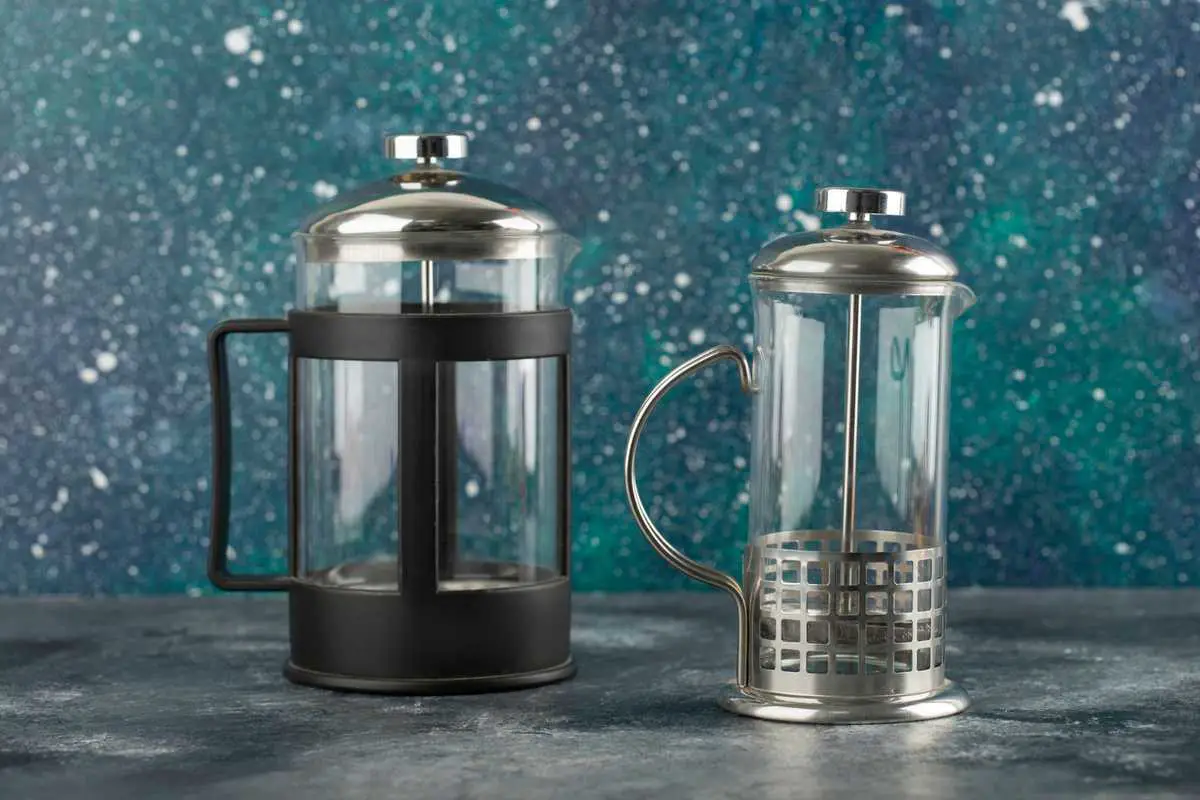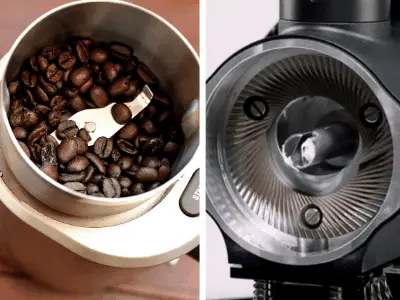Glass vs Stainless Steel French Press: Which Is Best for You?
Choosing the right material for your French press makes a big difference. Whilst most presses are made from glass, this begs the question: which one is the best, glass vs stainless steel French Press?
Stainless steel French presses are the best choice in terms of durability. Whilst glass is highly prone to shattering, stainless steel is unbreakable. Stainless steel also has the added benefit of keeping your coffee hotter for longer. One downside to stainless steel is that you’re not able to see the coffee as you can with glass.
Whilst I personally prefer the durability of stainless steel, many prefer the allure and elegance of glass. Let’s take an in-depth look at both materials so that you can decide which is best for you.
Advantages and disadvantages of a glass French press
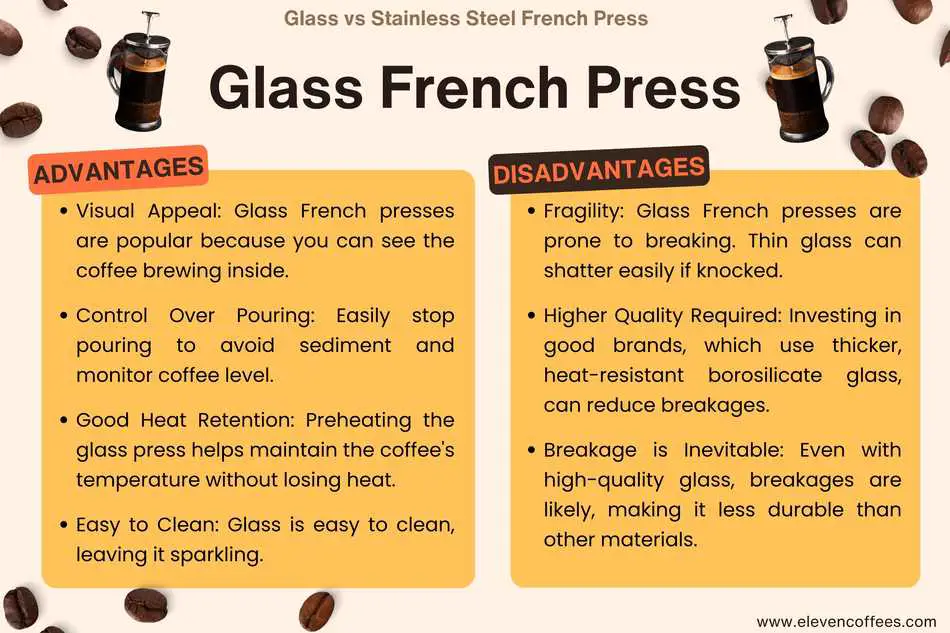
The classic French press is usually made from glass. The allure of being able to watch the coffee brew inside is why we love it so much and why it remains such a favourite the world over.
If you’ve ever drunk coffee from a French press, you’ll know that it’s important to avoid pouring out every last drop in order to reduce the amount of ground coffee sediment at the bottom of your cup.
A glass French press enables you to see when you’re at the perfect point to stop pouring. Plus, you can see how much coffee you have left, so you know when it’s time to make a fresh batch.
Glass French presses also hold the heat fairly well when compared to other materials. Whilst it’s always a good idea to preheat your coffee maker before using it, you’ll notice that the glass material doesn’t suck too much heat into the walls of the brewer, ensuring that your coffee stays lovely and hot.
Some materials are harder to clean than others, but getting glass sparkling clean is easy to do. However, the problem with cleaning glass is the increased risk of breakages.
Many manufacturers make cheap glass French presses from thin glass that shatters easily if you accidentally knock it against something.
Bodum Chambord
For this reason, it’s worth investing in a good brand such as Bodum. Bodum constructs glass carafes from thicker, heat-resistant borosilicate glass to enhance durability.
The great thing about buying a brand such as Bodum is that you can easily purchase a new carafe should you break your existing one.
One way to decrease the chance of shattering a glass French press is to buy one that has a metal frame. Cleaning the French press whilst inside the protective metal housing greatly reduces breakages.
Whilst my favourite glass French press is this premium Bodum Chambord, I have vowed never again to buy glass because they are just so prone to breaking. It’s not if it breaks, it’s when.
A few years back, I bought myself a stainless steel French press, and I don’t regret it one bit. Here’s why.
Advantages and disadvantages of a stainless steel French press
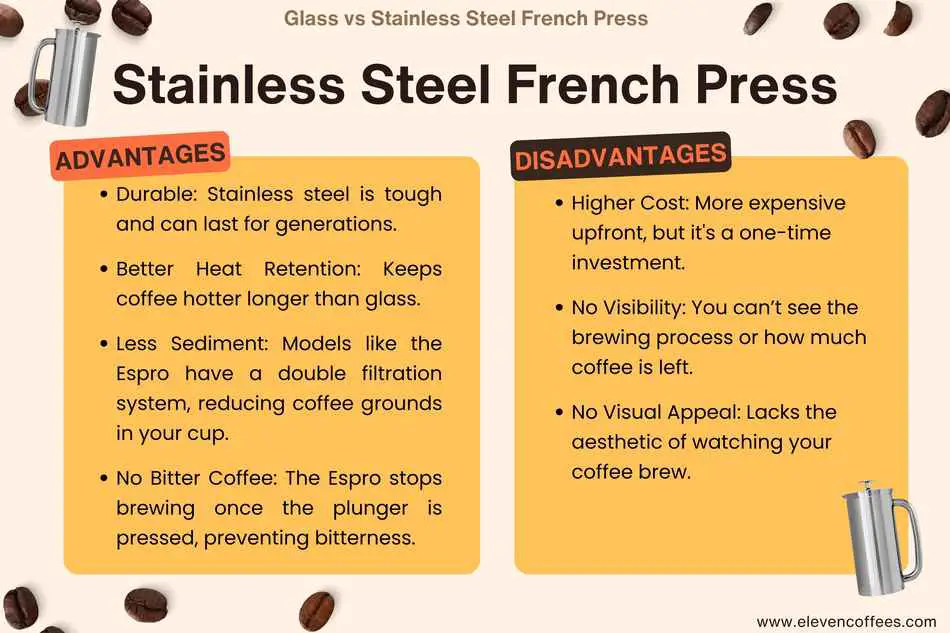
The stainless steel French press (Amazon link) is becoming more and more popular, particularly in trendy specialty coffee shops where the risk of breakages is very high.
Although good quality stainless steel French presses are generally more expensive than their glass counterparts, the investment is well worth it as it’s really a one-time purchase. You’ll be able to hand this thing down for generations to come.
Yes, you’ll have to part with a greater chunk of money in order to buy a stainless steel model, but you’ll only end up spending that same amount in replacement carafes if you decide to go for the glass option.
When it comes to heat retention, stainless steel comes out as winner once again. Stainless steel absorbs the heat from the brew water less quickly and also keeps your coffee hotter for longer.
One unfortunate thing about a metal French press is that you’re not able to see the brewing process happen. I totally get how you would want to see this happening as, after-all, we eat (and drink!) with our eyes first.
It’s also a pity that you can’t see how much coffee remains, especially when you reach those last few drops that you don’t want in your cup.
Stainless Steel Espro Press
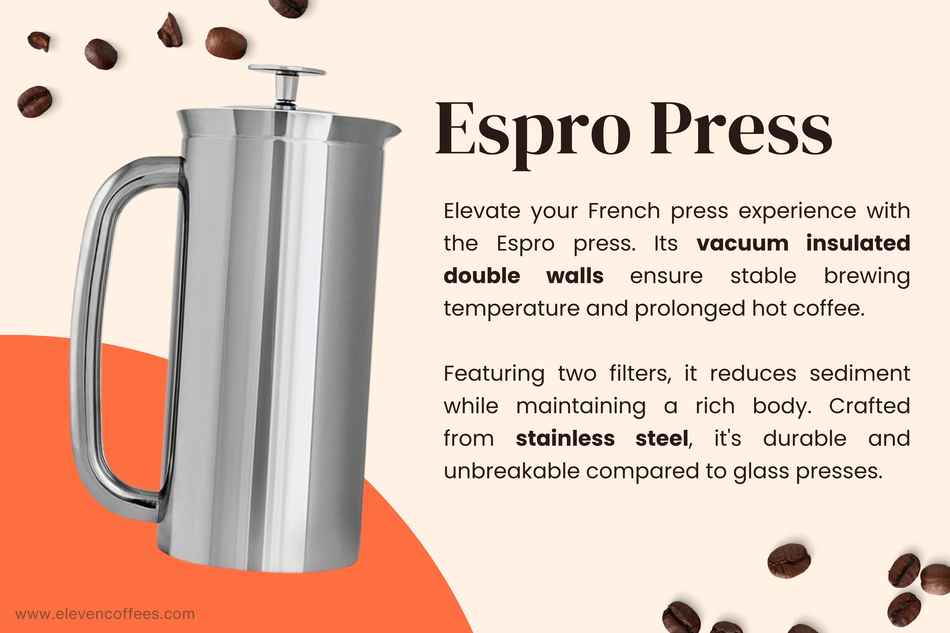
Although this might sound like I’m making the case for buying a glass version, the stainless steel Espro press really eliminates all these issues.
Whilst most other French presses only feature only one mesh filter, The Espro press has a unique double filtration system. What’s more, the filter holes are a lot smaller, meaning that far less ground coffee sediment is able to pass through.
What this means is that you get to enjoy the same great taste and body as you would with any other French press but without having to ingest any of the sediment.
The Espro is also double-walled and vacuum-insulated, which means that your coffee stays hotter for even longer than other stainless steel presses.
You don’t even have to worry about decanting the coffee to avoid your coffee becoming bitter. When you press the plunger down, extraction stops immediately. The double micro-filter is surrounded by a silicone lip that runs along the rim, which fits snugly inside the container and creates a vacuum seal.
I love that my coffee tastes perfect from the first cup to the last and that I don’t have to worry about it turning bitter or getting cold from decanting into another carafe.
Check out the current price of the Espro press on Amazon, and enjoy the best French press coffee of your life.
What else you must consider when buying a French press
If I haven’t convinced you to buy an Espro, the king of French presses, then make sure to consider these other factors when choosing a French press.

Cup size
Whilst some French presses display the capacity in litres or fluid ounces, many display their capacity in terms of cups. However, the measurement of a cup on a French press isn’t equal to the standard 1 US cup that measures 8fl oz (237ml).
Confusingly, the measurement of each individual cup is 4.2fl oz (125ml). Unless it were espresso, this amount of liquid would be a very small serving of coffee, especially as most standard coffee mugs hold twice that amount.
Fortunately, you don’t have to be a math’s whizz to work out the size of French press you need. Just divide the number of cup sizes by two, and this will tell you how many mugs of coffee your French press can make.
Removable filter
Some very cheap French presses include plungers with a two-part fixed filter. Standard French press filters usually consist of three parts, made up of a spiral plate, mesh filter screen and cross plate, which are all fully detachable.
Being able to detach the filter assembly is hugely important in order to clean it effectively. Coffee grounds get stuck between the filter assembly, and the only way to remove them is to take it apart.
Failure to do so will lead to bitter and nasty tasting coffee as you’ll be brewing the same grounds twice.
So when you’re out shopping for your next press, make sure to open up the box and take a good look at the filter assembly. Ensure that it consists of three parts and that they’re all detachable.
Replacement parts (especially carafes)
Many manufacturers of cheap French presses do not supply replacement parts should they wear out or break.
Over time, the mesh filter will become misshapen. It will no longer filter the ground coffee as effectively as it did when new.
The mesh filter also becomes discolored due to the oils in coffee. This can leave a harsh, burnt taste in your brew. Therefore, it’s important to replace the filter occasionally to ensure delicious-tasting coffee.
If you decide to buy a glass French press, choose a brand that sells replacement glass carafes. One of the downsides of very cheap French presses is that the glass carafe is often glued to the plastic housing, making it impossible to replace.
Replacement parts from reputable manufacturers like Bodum and Espro are readily available on Amazon or their websites. Keep this in mind, as it can save you money on a new press in the future.
Unless you’ve been paying absolutely zero attention, you’ll be well aware that glass French presses are prone to breaking.
For that reason, it’s crucial to buy from a manufacturer that produces quality glass carafes. As mentioned earlier, ensure the carafe is made from borosilicate glass and has a nice thickness to withstand knocks.
Don’t skimp on quality. Aim to spend a minimum of $25 (£20) to ensure it won’t break after just five minutes.

